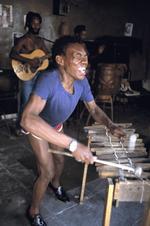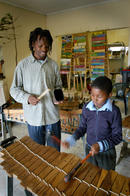Original Design

The marimba is one of the oldest and most popular Southern African instruments, reworked and reshaped over the years to form the modern-day marimba. Also known as the xylophone, the marimba’s origins are not completely known, but it is believed to have originated in Southeast Asia during the 14th century. It has also been theorized that it originated somewhere in Africa, but it became globalised during the 16th century, when African slaves brought the instrument to South America and later North America.
Today the marimba is played in Guatemala, southwestern Nicaragua and northwestern Costa Rica, and has a strong resemblance to African xylophones. The word ‘marimba’ is related to African Bantu languages, all referring to a type of musical instrument, such as the mbira, which is used by the Venda and XiTsonga tribes of South Africa. The words silimba or sirimba, timbila, andamadimba, or madimba all refer to a sort of xylophone in African languages.
The original 14th century marimba instrument comprised of two or three slabs of disconnected wood, which would be laid across the musician’s legs seated on the ground. The musician would hook his legs under the leg of wood to stabilize the instrument. The early forms of marimbas had wooden bars/keys, with suspended gourds below. Each gourd was individually tuned to the pitch of its corresponding key. Examples of such marimbas can still found in rural villages throughout Africa and Mexico.
Individual Style

Different cultures from various countries, each have their own structure and style of marimba. Depending on the marimba’s length, width and depth, it will produce a different sound. However, the design and keys of the instrument are inherently similar throughout most countries. In the south-west region of Cameroon in Africa, for example, the log-xylophone consists of 15 wooden keys placed on top of two long banana-tree trunks for support.
This instrument can be played by two or three people, sitting on both sides rather than next to each other. The keys are not fixed to the tree trunks, so one of the players needs to ensure that the keys are in place after it has been struck. Modern-day marimbas are mostly made of rosewood with aluminium or brass resonators (pipes). The resonators are closed on one end and vary in length, depending on the key length. They are tuned to the wooden bar’s fundamental pitch. It has a two-level keyboard, which is similar to a piano’s black-and-white keys.
A solo marimba is between four-and-a-third and five octaves, while an orchestral marimba is four octaves. Mallets are used to produce sound by hitting the wooden bar. They are typically made from birch or rattan, topped with heads of rubber, plastic, or wood wrapped in cord or yarn. A heavy mallet allows for longer contact with the bar, which produces a louder sound. A light mallet rebounds quickly, producing a softer sound.